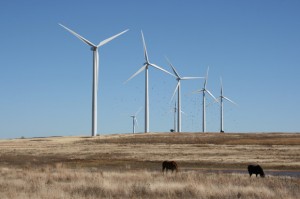New York Times: A ‘Blue Light Special’ on Wind Power in Oklahoma
-
Joe Wertz
The cost of producing and providing electricity generated by solar panels and wind turbines has plunged in recent years, and are on track to meet — and in some markets are already beating — the generation costs of conventional sources like coal and natural gas.
Price parity has been a “long-held dream” of the solar and wind industries, The New York Times‘ Diane Cardwell reports. And alternative energy is proving competitive to conventional energy sources — especially in Oklahoma:
In September, the Grand River Dam Authority in Oklahoma announced its approval of a new agreement to buy power from a new wind farm expected to be completed next year. Grand River estimated the deal would save its customers roughly $50 million from the project.
And, also in Oklahoma, American Electric Power ended up tripling the amount of wind power it had originally sought after seeing how low the bids came in last year.
“Wind was on sale — it was a Blue Light Special,” said Jay Godfrey, managing director of renewable energy for the company. He noted that Oklahoma, unlike many states, did not require utilities to buy power from renewable sources.
“We were doing it because it made sense for our ratepayers,” he said.
The low cost of wind and solar are bolstered by subsidies “that could soon diminish or expire,” NYT reports. But even without subsidies, which have been a legislative target and source of opposition in wind-rich Oklahoma, renewables in many markets are still competitive, Caldwell writes:
According to a study by the investment banking firm Lazard, the cost of utility-scale solar energy is as low as 5.6 cents a kilowatt-hour, and wind is as low as 1.4 cents. In comparison, natural gas comes at 6.1 cents a kilowatt-hour on the low end and coal at 6.6 cents. Without subsidies, the firm’s analysis shows, solar costs about 7.2 cents a kilowatt-hour at the low end, with wind at 3.7 cents.
Both conventional and alternative electricity sources come with “hidden costs,” Jonathan Mir, a managing director at Lazard tells NYT: Wind and solar can be intermittent, which requires utilities to draw on other sources to meet demand; many conventional sources produce pollution, which face increasing fees.
But in a straight comparison of the costs of generating power, Mr. Mir said that the amount solar and wind developers needed to earn from each kilowatt-hour they sell from new projects was often “essentially competitive with what would otherwise be had from newly constructed conventional generation.”

